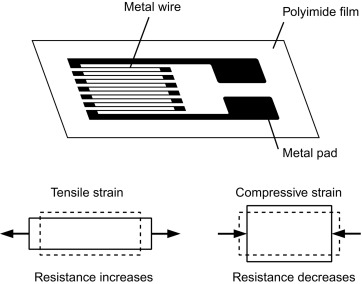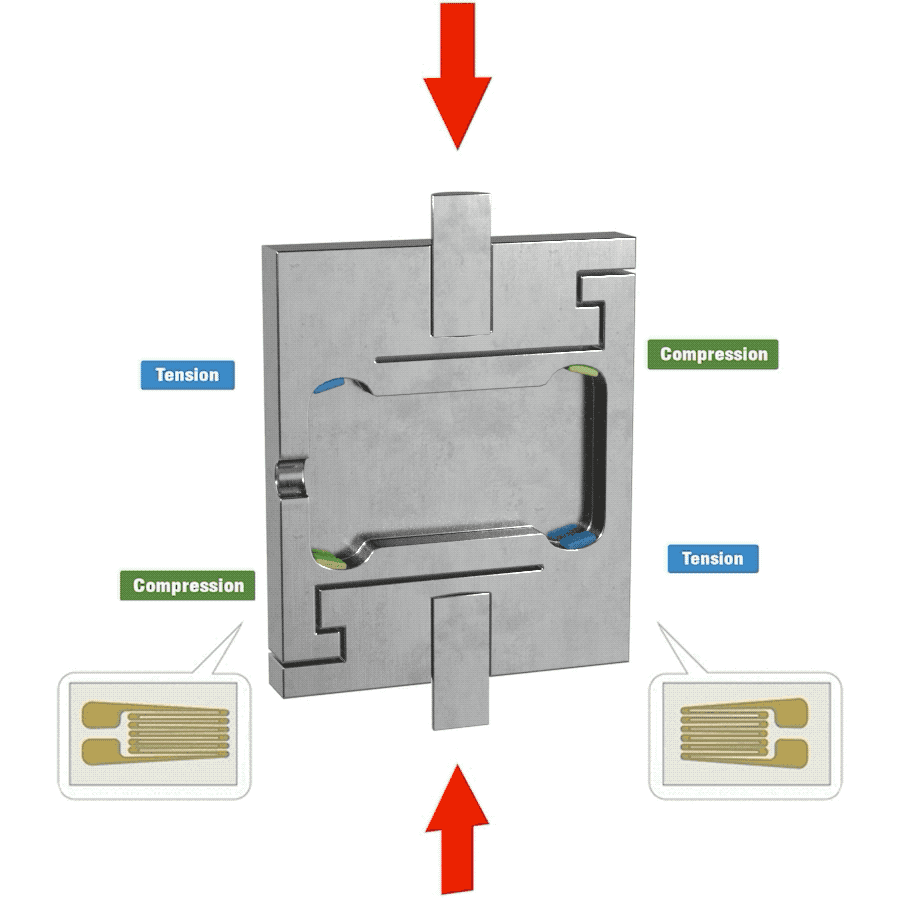How does a Loadcell (force transducer) work ?
What is a Load Cell, Force Sensor or Force Transducer?
By definition, load cell (or loadcell) is a type of transducer, specifically a force transducer. It converts an input mechanical force such as load, weight (aka weight sensors), tension, compression or pressure (aka pressure sensors for pressure measurement - What is a pressure sensor?) into another physical variable, in this case, into an electrical output signal that can be measured, converted and standardized. As the force applied to the force sensor increases, the electrical signal changes proportionally.
Force Transducers became an essential element in many industries from Automotive, High precision manufacturing, Aerospace & Defense, Industrial Automation, Medical & Pharmaceuticals and Robotics where reliable and high precision load measurement is paramount (i.e. medical load cell). Most recently, with the advancements in Collaborative Robots (Cobots) and Surgical Robotics, many novel force measurement applications are emerging, such as miniature medical sensors for robotic surgery.
How does a load cell work?
Firstly, we need to understand the underlying physics and material science behind the load cell working principle, which is the strain gauge (sometimes referred to as Strain gage). Metal foil strain gage is a material whose electrical resistance varies with applied force. In other words, it converts (or transduces) force, pressure, tension, compression, torque, weight, etc… into a change in electrical resistance, which can then be measured. So, metal foil strain gauge is the building block of force sensor working principle. Weight measurement using strain gauge bridge is also one of the comment applications of this technology.
Strain gauges are electrical conductors tightly attached to a film in a zigzag shape. When this film is pulled, it – and the conductors – stretches and elongates. When it is pushed, it is contracted and gets shorter. This change in shape causes the resistance in the electrical conductors to also change. The strain applied in the load cell can be determined based on this principle, as strain gauge resistance increases with applied strain and diminishes with contraction.

Structurally, a force sensor (or transducer) is made of a metal body (also called flexure) to which foil strain gauges are bonded. The sensor body is usually made of aluminum or stainless steel, which gives the sensor two important characteristics: (1) provides the sturdiness to withstand high loads and (2) has the elasticity to minimally deform and return to its original shape when the force is removed.
When force (tension or compression) is applied, the metal body acts as a “spring” and is slightly deformed, and unless it is overloaded, it returns to its original shape. As the flexure deforms, the strain gage also changes its shape and consequently its electrical resistance, which creates a differential voltage variation through a Wheatstone Bridge circuit. Thus, the change in voltage is proportional to the physical force applied to the flexure.

These strain gauges are arranged in what is called a Wheatstone Bridge Circuit (see load cell circuit animated diagram). This means that four strain gages are interconnected as a loop circuit and the measuring grid of the force being measured is aligned accordingly.
The load cell amplifier module (or load cell signal converters) provide regulated excitation voltage to the load cell Wheatstone bridge amplifier and convert the mv/V output signal into another form of signal that is more useful to the user. The signal generated by the strain gage bridge is low strength signal and may not work with other components of the system, such as PLC, data acquisition modules (DAQ), load cell data logger, computers, or microprocessors. Thus, strain gauge amplifier functions include excitation voltage, noise filtering or attenuation, signal amplification, and output signal conversion (i.e. load cell ADC ).
Furthermore, the change in the strain gauge amplifier voltage output is calibrated to be linearly proportional to the Newtonian force applied to the flexure.

An important concept regarding force transducers is load cell sensitivity and accuracy. Force Sensor accuracy can be defined as the smallest amount of force that can be applied to the sensor body required to cause a linear and repeatable variation in the voltage output. The higher the force transducer load cell accuracy, the better, as it can consistently capture very sensible force variations. In applications like high precision factory automation, surgical robotics, aerospace, load cell linearity is paramount in order to accurately feed the PLC or DAQ control system with the accurate force measurement. Some of our Universal Pancake Load Cells presents Nonlinearity of ±0.1% (of Rated Output) and Nonrepeatability of ±0.05% RO.
What are the advantages of strain gage-based load cells?
Metal foil strain gauge load cell sensors (not a draw wire sensor) are the most common technology, given its high accuracy, long term reliability, variety of shapes and sensor geometry and cost-effectiveness when compared to other force measurement technologies. Also, strain gage force measuring sensors are less affected by temperature variations.
- The highest accuracy which may conform to many standards from Surgical Robotics to Aerospace;
- Robust Construction made of either high strength Stainless steel or Aluminum;
- Maintain high performance at the longest possible work life even at the most rigorous conditions. Some load cell designs can go up to billions of fully reversed cycles (lifespan).
- A plethora of geometries and customized shapes, as well as mounting options for ANY scale ANY-where.
- A full gamut of selections with capacities ranging from 10 grams to 100,000 pounds.
What are the types of Load Cells?
Although there several technologies to measuring force, we will focus on the most common type of load cell: metal foil strain gauge. Within the types of force sensors, there are a variety of body shapes and geometries, each one catering to distinct applications. Get to know them if you want to buy load cell:
- In-Line Load Cell – Most commonly referred to as in-line force transducers force sensor with male threads. This style of load force transducer can be used in both pushing and pulling forces applications (aka push-pull load cell). In-line sensors offer high accuracy and high stiffness with minimal mounting clearance needed. They are great for endurance, press in force measurement applications and force measurement sensor for gym workout equipment. Also offered in miniaturized versions as micro load cell (aka micro force sensor, miniature load cell, miniature force sensor or milligram load cell).
- Column Load Cell – FUTEK provides a wide range of Canister Load Cells (also known as Column Load Cell) designed for high capacity compression applications such as CNC Machine Vise Clamping Force Test. These models offer robust construction with a capacity ranging from 2,000 to 30,000 lbs. FUTEK has also developed a miniature Load Cell Canister series for applications where size is a critical factor.
- Load Button – These force transducers have a single flat, raised surface (aka a button) where the compressive force is applied. What’s impressive about load buttons is their low profile load cell design. As small load cells as they are, they are known for their robustness and are used in fatigue applications. Some applications require miniature modes such as the LLB130 subminiature load cell load button. Rolling element bearing load measurement is an application where load buttons are utilized.
- S Beam Load Cell – With other names including Z Beam Sensor, S Type load cell, the S Beam Load Cell is a tension load cell and compression load cell with female threads for mounting. Sporting high accuracy and a thin beam load cell, compact profile, this force sensor type is great for in-line processing and automated control feedback applications. S Beam Load cells can also be used as a non contact flow sensor in fluid flow measurement application.
- Thru Hole Load Cell – Also known as donut load cell or washer load cell, thru hole load cell traditionally have a smooth non-threaded inner diameter used to measure compressive loads that require a rod to pass through its center. One of the primary uses of this sensor type is to measure bolt loading.
- Pancake Load Cells – Pancake load cell, universal load or shear web load cell have a central threaded hole for measuring loads in either tension or compression. These force transducers are used in applications needing high endurance, high fatigue life, or high-capacity in-line measurements, such as material force testing, load cell for tanks weighing system or crane load cell applications. They are also highly resistant to off-axis loading and are also available as low profile pancake load cell.
- Rod End Load Cell – Also known as Actuator Load Cell, this load transducer type offers one male thread and one female thread for mounting. The male and female thread combination is well suited in applications where you need to adapt a force sensor into an existing fixture.
- Bending Beam Load Cell - Offers a slim design making it ideal for OEM applications. Utilized in Compression, the Bending Beam Load Cells can be used to measure force, surface pressure and displacement for OEM Applications. With its miniature size, the Cantilever Load Cell is a great selection for tight environments.
- Single Point Load Cell - Side mounted load cell with a single point design that are specifically made for OEM applications that require high precision or high volume production. Also known as Shear Beam Load cell, these strain gauged based force sensors measure tension and compression and are also known as compact parallelogram sensors, or single point load cell. Side mount load cells such as the LSM Series sensors are a recommended OEM weight measurement solution and are sensors used in bottle filling plant.
Other unique designs are also available such as the load pin load cells (aka load cell pin), seat belt load cell, and others.
This text was written by FUTEK Advance Sensor Technology in USA. PIMZOS is the distributor for FUTEK in the Benelux.

